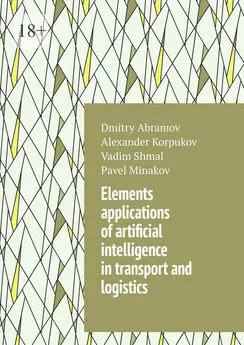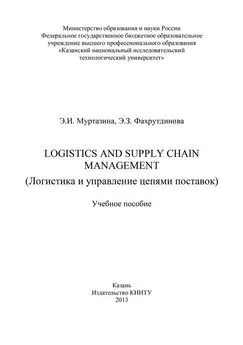Dmitry Abramov - Elements applications of artificial intelligence in transport and logistics
- Название:Elements applications of artificial intelligence in transport and logistics
- Автор:
- Жанр:
- Издательство:неизвестно
- Год:неизвестен
- ISBN:9785005566744
- Рейтинг:
- Избранное:Добавить в избранное
-
Отзывы:
-
Ваша оценка:
Dmitry Abramov - Elements applications of artificial intelligence in transport and logistics краткое содержание
Elements applications of artificial intelligence in transport and logistics - читать онлайн бесплатно ознакомительный отрывок
Интервал:
Закладка:
Minsky explained:
«The starting point was the work we did on the correlations between brain activity and human behavior. It was very clear to us that these correlations cannot be understood without first understanding how behavior is generated.»
The authors came to the conclusion that any inorganic system can act only on the basis of its internal states. If the internal states changed, then the behavior of the system would change. When the authors thought of a brain that responds to certain types of brain waves, they noticed that the brain would produce a certain behavior, and that this behavior would correspond to the internal state of the brain. This is a universal principle of nature. Since this principle of nature made behavior universal, it should lead the authors to the conclusion that if they applied these principles to the brain, they could create a computer program that would be able to reproduce the behavior of the brain.
Minsky believed that universal principles governing biological systems could be used to create computer software. However, Minsky admitted that his ideas were «science fiction.» It took Minsky and Simon another year to find a way to create a computer that could mimic their discoveries. But by 1972, they had developed a computer program that could test their theories.
John B. Barg, professor of psychology at Yale University, was also instrumental in the development of Minsky and Simon’s research. Barg helped found the Center for Behavioral Neuroscience at the University of Michigan in 1972, where Minsky and Simon continued to experiment with human and animal behavior.
The field of artificial intelligence research began in a seminar at Dartmouth College in 1956, where the term «artificial intelligence» was first coined. The following year, in 1957, Massachusetts Institute of Technology, together with its research graduate students, formed a new organization of AI researchers called the SIGINT-A (Intelligence and Scientific Computing) Committee. After creating many of the foundations of artificial intelligence, members of this group did some research on a similar program at Stanford University. The group decided to keep the name SIGINT-A and develop a new research and development program in the field of artificial intelligence. SIGINT-A became the research and development group that eventually became the world famous artificial intelligence laboratory that now bears his name. SIGINT-A is a legendary research organization. There are many famous names in this area in its history. Many famous names in the field of AI have been taken from SIGINT-A. Many projects have been implemented in the laboratory. To meet engineering needs or to fulfill a new mission in a new era of artificial intelligence, SIGINT-A has never been afraid to try new things. And many of her ideas and directions have been accepted in the generally accepted field. Many of what we now regard as leading AI tools, such as neural networks and helper vector machines, were created or adapted in the SIGINT-A era.
Computer science defines AI research as the study of «intelligent agents»: any device that perceives the environment and takes action based on what it perceives.
It is a common misconception that artificial intelligence research focuses on creating technologies that resemble human intelligence. However, as Alan Turing wrote, the most important attributes of human intelligence are not the pursuit of mathematical knowledge and the ability to reason, but the ability to learn from experience, perceive the environment, and so on. To understand how these properties of human intelligence can be used to improve other technologies, one must understand these characteristics of human intelligence.
AI researchers and entrepreneurs use the term «artificial intelligence» to define software and algorithms that demonstrate human intelligence. The academic area has since expanded to cover related topics such as natural language processing and systems. Much of the work in this area takes place in universities, research institutes and companies, with investments from companies like Microsoft and Google.
Artificial intelligence is also used in other industries, such as the automatic control of ships, and is commonly used in the development of robotics. Examples of AI applications include speech recognition, image recognition, language processing, computer vision, decision making, robotics, and commercial products including language translation and recommendation engines. Artificial intelligence is at the center of national and international public policy such as the National Science Foundation. Research and development in artificial intelligence is managed by independent organizations that receive grants from public and private agencies. Other organizations, such as The Institute for the Future, have a wealth of information on AI and other emerging technologies and design professions, as well as the talent required to work with those technologies.
The definition of artificial intelligence has evolved since the concept was developed and it is currently not a black and white definition, but rather a continuum. From the 1950s to the 1970s, AI research focused on the automation of mechanical functions. Researchers such as John McCarthy and Marvin Minsky have explored the problems of general computing, general artificial intelligence, reasoning, and memory.
In 1973, Christopher Chabris and Daniel Simons proposed a thought experiment called The Incompatibility of AI and Human Intelligence. The problem described was that if the artificial system was so smart that it was superior to humans or superior to human capabilities, the system could make whatever decisions it wanted. This can violate the fundamental human assumption that people should have the right to make their own choices.
In the late 1970s and early 1980s, the field of activity changed from the classical orientation towards computers to the creation of artificial neural networks. Researchers began to look for ways to teach computers to learn rather than just perform certain tasks. This field developed rapidly during the 1970s and eventually moved from computing to a more scientific-oriented one, and its field of application expanded from computing to human perception and action.
Many researchers in the 1970s and 1980s focused on defining the boundaries of human and computer intelligence, or the capabilities required for artificial intelligence. The boundary should be wide enough to cover the full range of human capabilities.
While the human brain is capable of processing gigabytes of data, it was difficult for leading researchers to imagine how an artificial brain could process much larger amounts of data. At the time, the computer was a primitive device and could only process single-digit percentages of data on a human scale.
During that era, artificial intelligence scientists also began work on algorithms to teach computers to learn from their own experience – a concept similar to how the human brain learns. Meanwhile, in parallel, a large number of computer scientists developed search methods that could solve complex problems by looking for a huge number of possible solutions.
Artificial intelligence research today continues to focus on automating specific tasks. This emphasis on the automation of cognitive tasks is called «narrow AI». Many researchers working in this field are working on facial recognition, language translation, playing chess, composing music, driving cars, playing computer games, and analyzing medical images. Over the next decade, narrow AI is expected to develop more specialized and advanced applications, including a computer system that can detect early stages of Alzheimer’s disease and analyze cancers.
The public uses and interacts with artificial intelligence every day, but the value of AI in education and business is often overlooked. AI has significant potential in almost all industries, such as pharmaceuticals, manufacturing, medicine, architecture, law and finance.
Companies are already using artificial intelligence to improve services, improve product quality, lower costs, improve customer service, and save money on data centers. For example, with robotics software, Southwest Airlines and Amadeus can better answer customer questions and use customer-generated reports to improve their productivity. Overall, AI will affect nearly every industry in the coming decades. On average, about 90% of U.S. jobs will be affected by AI by 2030, but the exact percentage varies by industry.
Artificial intelligence can dramatically improve many aspects of our lives. There is a lot of potential for improving health and treating illness and injury, restoring the environment, personal safety, and more. This potential has generated a lot of discussion and debate about its impact on humanity. AI has been shown to be far superior to humans in a variety of tasks such as machine vision, speech recognition, machine learning, language translation, computer vision, natural language processing, pattern recognition, cryptography, chess.
Many of the fundamental technologies developed in the 1960s were largely abandoned by the late 1990s, leaving gaps in this area. Fundamental technologies that define AI today, such as neural networks, data structures, and so on. Many modern artificial intelligence technologies are based on these ideas and are much more powerful than their predecessors. Due to the slow pace of change in the tech industry, while current advances have produced some interesting and impressive results, there is little to distinguish them from each other.
Early research in artificial intelligence focused on learning machines that used a knowledge base to change their behavior. In 1970, Marvin Minsky published a concept paper on LISP machines. In 1973, Turing proposed a similar language called ML, which, unlike LISP, recognized a subset of finite and formal sets for inclusion.
In the decades that followed, researchers were able to refine the concepts of natural language processing and knowledge representation. This advance has led to the development of the ubiquitous natural language processing and machine translation technologies in use today.
In 1978, Andrew Ng and Andrew Hsey wrote an influential review article in the journal Nature containing over 2,000 papers on AI and robotic systems. The paper covered many aspects of this area such as modeling, reinforcement learning, decision trees, and social media.
Since then, it has become increasingly difficult to involve researchers in natural language processing, and new advances in robotics and digital sensing have surpassed the state of the art in natural language processing.
In the early 2000s, a lot of attention was paid to the introduction of machine learning. Learning algorithms are mathematical systems that learn by observation.
In the 1960s, Bendixon and Ruelle began to apply the concepts of learning machines to education and beyond. Their innovations inspired researchers to further explore this area, and many research papers were published in this area in the 1990s.
Sumit Chintal’s 2002 article, Learning with Fake Data, discusses a feedback system in which artificial intelligence learns by experimenting with the data it receives as input.
In 2006, Judofsky, Stein, and Tucker published an article on deep learning that proposed a scalable deep neural network architecture.
In 2007, Rohit described" hyperparameters». The term "hyperparameter" is used to describe a mathematical formula that is used in computer learning. While it is possible to design systems with tens, hundreds, or thousands of hyperparameters, the number of parameters must be carefully controlled because overloading the system with too many hyperparameters can degrade performance.
Читать дальшеИнтервал:
Закладка:










